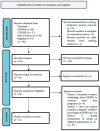Pregnant Women's Knowledge of Pelvic Floor and Related Dysfunctions: A Scoping Review
- PMID: 40281796
- PMCID: PMC12026911
- DOI: 10.3390/healthcare13080847
Pregnant Women's Knowledge of Pelvic Floor and Related Dysfunctions: A Scoping Review
Abstract
Pregnancy and childbirth can have far-reaching effects on women's pelvic floor health. It is important to educate pregnant women about pelvic floor health and potential birth-related pelvic floor (PF) changes as part of continuous midwifery care. This scoping review aims to identify the current state of research on knowledge and knowledge gaps in pregnant women regarding the PF and PF dysfunction (PFD) in order to derive conclusions and recommendations for midwifery care and midwifery science. This review follows the Arksey and O'Malley framework and the PRISMA Statement. The literature search was conducted on databases PubMed, CINAHL, and Web of Science using various search terms and defined inclusion criteria. Eleven articles were included. The results show a considerable context-related knowledge deficit among pregnant women, with a high prevalence of PFDs such as urinary incontinence (UI), fecal incontinence (FI), or prolapse symptoms (POP). All contributions emphasize the importance of improved specific education and health advice regarding the PF and PFD for pregnant women to close knowledge gaps and promote sustainable PF health. Demands are made on the professional group 'midwife', which emphasize the importance of specific and target group-appropriate educational concepts on the subject of the PF and PFD.
Keywords: attitudes; awareness; health knowledge; pelvic floor; pelvic floor disorders; pregnancy; pregnant women.
Conflict of interest statement
The authors declare no conflicts of interest.
References
Publication types
LinkOut - more resources
Full Text Sources


